Ghana is a country full of life, culture, and history, with its bustling cities and famous landmarks like Accra, Kakum National Park, and the Cape Coast Castle drawing in most of the visitors. But what about the places that aren’t as well-known, those off-the-beaten-path spots that capture the soul of the country in a way that the usual tourist spots sometimes don’t?
There are quiet waterfalls hidden in lush forests, charming coastal towns with a slow pace of life, and villages where tradition is alive and well. These places, though less visited, offer some of the most authentic and peaceful experiences you can have in Ghana.
In this blogpost, we’ll take you on a journey to explore some of these lesser-known gems of Ghana. Whether you’re looking for a secluded getaway, a deep dive into local culture, or simply a break from the crowds, these hidden spots are waiting to be discovered. So, if you want to see another side of Ghana, let’s dive into these hidden treasures together.
Hidden Beach Destinations in Ghana
Coastline in Ghana stretches over 500 kilometers, but beyond the well-known beaches of Labadi and Kokrobite, there are hidden gems waiting to be discovered. These secluded beaches offer unspoiled beauty, fewer crowds, and an authentic connection with nature.



1. Ankobra Beach (Western Region)
Location: Near Axim, Western Region
Why Visit?
Ankobra Beach is a serene paradise with golden sand, swaying palm trees, and a tranquil atmosphere. Unlike busy tourist beaches, this stretch remains largely untouched, making it perfect for travelers looking to escape the crowds. The beach is backed by a lush green landscape, and the sunsets here are absolutely breathtaking.
Activities:
- Relaxation and sunbathing in a peaceful environment
- Canoe rides on the Ankobra River
- Fresh seafood from local fishermen
How to Get There:
From Takoradi, take a bus or private car towards Axim. The beach is a short drive from the town center.
2. Cape Three Points Beach (Western Region)
Location: Near the southernmost tip of Ghana
Why Visit?
Cape Three Points is a dream for nature lovers and adventure seekers. It is home to Ghana’s southernmost lighthouse, offering a stunning panoramic view of the Atlantic Ocean. The waters here are pristine, and the beach is surrounded by lush tropical forest.
Activities:
- Hiking to the lighthouse for a breathtaking view
- Surfing and swimming in the clear waters
- Visiting the nearby eco-lodge for an off-grid experience
How to Get There:
From Takoradi, take a bus to Agona Junction, then hire a local taxi or motorbike to Cape Three Points.
3. Ada Foah Beach (Greater Accra Region)
Location: Ada Foah, where the Volta River meets the Atlantic Ocean
Why Visit?
This beach is a hidden oasis with soft white sand and calm waters. The unique thing about Ada Foah is the estuary, where the Volta River flows into the ocean, creating a stunning contrast of freshwater and saltwater.
Activities:
- Boat rides along the Volta River
- Birdwatching in the surrounding wetlands
- Relaxing at riverfront lodges with stunning views
How to Get There:
From Accra, take a public bus or trotro to Ada Foah. From the town center, a local taxi can take you to the beach.
4. Azizadzi Beach (Volta Region)
Location: Near Keta, Volta Region
Why Visit?
Azizadzi Beach remains one of Ghana’s best-kept secrets. It’s peaceful, lined with coconut trees, and has an almost untouched beauty. The waves here are gentle, making it perfect for swimming.
Activities:
- Fishing with local fishermen
- Visiting the nearby Keta Lagoon
- Watching sea turtles (during the nesting season)
How to Get There:
From Accra, take a bus to Keta and then a short taxi ride to Azizadzi.
Wli Waterfalls: Ghana’s Tallest and Most Breathtaking Falls
Wli Waterfalls, located in the Volta Region near the Togo border, is Ghana’s tallest waterfall and one of the most stunning natural wonders in the country. Nestled within the lush greenery of the Agumatsa Wildlife Sanctuary, Wli is a hidden paradise for nature lovers, hikers, and adventure seekers. Despite its beauty, it remains relatively underrated compared to Ghana’s more mainstream tourist attractions.

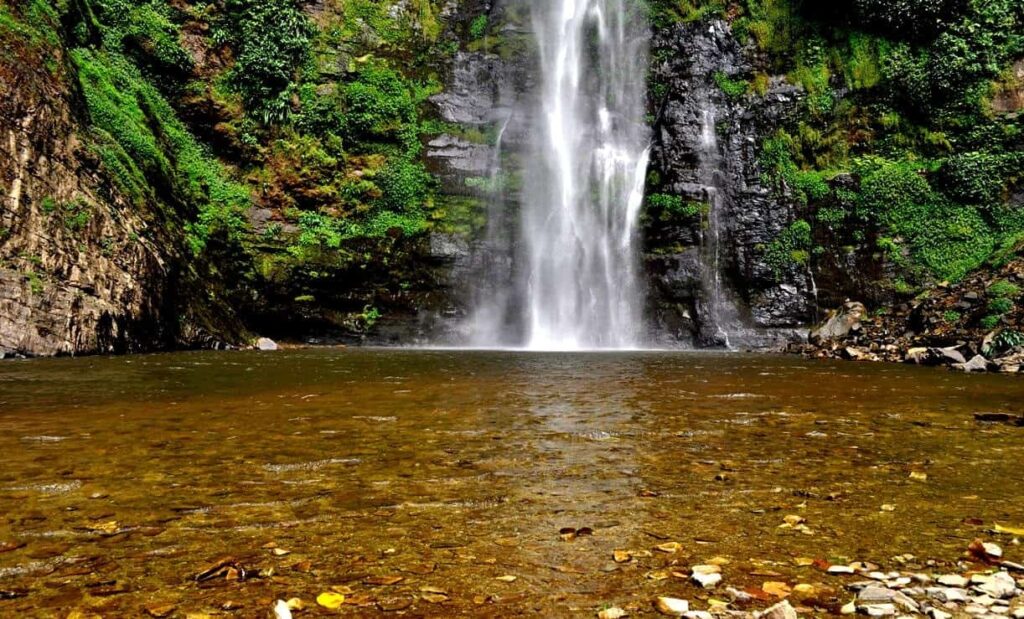

Why Visit Wli Waterfalls?
Wli Waterfalls is a two-tiered waterfall that cascades from a height of about 80 meters, creating a breathtaking sight and a refreshing mist. The falls are surrounded by rich tropical forest, home to a variety of wildlife, including over 200 species of butterflies and fruit bats.
What Makes Wli Waterfalls Special?
- Tallest Waterfall in Ghana: The dramatic height and volume of the falls make it a spectacular sight.
- Rich Biodiversity: The surrounding forest is home to diverse flora and fauna, making the journey to the falls an experience in itself.
- Refreshing Natural Pool: At the base of the falls, visitors can take a dip in the cool, refreshing pool.
- Choice of Hiking Trails: There are two main routes – the easier Lower Falls hike and the more challenging Upper Falls hike.
Activities at Wli Waterfalls
There’s plenty to do at Wli Waterfalls, whether you’re seeking adventure or relaxation.
- Hiking to the Falls – The hike to the Lower Falls takes about 45 minutes on a well-maintained path. For a more intense experience, the Upper Falls hike takes about 3 hours and offers breathtaking views.
- Swimming – The natural pool at the base of the falls provides a cool escape, perfect after a long hike.
- Birdwatching & Wildlife Spotting – The Agumatsa Wildlife Sanctuary is home to birds, butterflies, and monkeys. You can also spot colonies of fruit bats clinging to the cliffs around the falls.
- Photography & Sightseeing – The picturesque scenery makes Wli an ideal spot for capturing stunning nature photography.
- Cultural Encounters – The nearby Wli Traditional Area offers insight into the local Ewe culture, with opportunities to visit the village and interact with locals.
Best Time to Visit
Wli Waterfalls is best visited during the rainy season (April to October) when the water flow is strongest, creating a dramatic and powerful cascade. However, the dry season (November to March) offers easier hikes and clearer trails.
Accommodation Near Wli Waterfalls
For those planning to stay overnight, there are comfortable accommodation options nearby:
- Wli Water Heights Hotel – A mid-range option with stunning views of the mountains and close proximity to the falls.
- Big Foot Safari Lodge – A budget-friendly guesthouse offering cozy rooms and an eco-friendly environment.
- Mountain Paradise Lodge (Biakpa) – Located a bit further away but provides breathtaking views of the Volta Region’s hills.
How to Get to Wli Waterfalls
- From Accra: Take a bus from Accra to Hohoe (approx. 4-5 hours). From Hohoe, hire a taxi or take a shared minibus to Wli (about 30 minutes).
- From Ho: If coming from Ho, take a direct minibus or taxi to Wli, which is about 1.5 hours away.
Estimated Costs
- Transportation from Accra to Hohoe: GHS 100–150 (by bus), GHS 300+ (private taxi)
- Entry Fee: GHS 20–30 (Ghanaians), GHS 50–100 (foreigners)
- Guide Fee for Upper Falls Hike: GHS 80–150 per group
- Accommodation: GHS 200–800 per night, depending on comfort level
- Local Food & Drinks: GHS 40–100 per meal
Boti Falls: A Twin Waterfall with a Mystical Aura
Boti Falls, located in the Eastern Region near Koforidua, is one of Ghana’s most beautiful and spiritually significant waterfalls. Unlike most waterfalls in Ghana, Boti Falls consists of two parallel waterfalls—one representing the male and the other the female—which merge when the water levels are high, symbolizing unity and harmony.
Tucked away in the lush Boti Forest Reserve, this waterfall is often overlooked in favor of more famous sites, but it offers a breathtaking experience for nature lovers and adventure seekers alike.


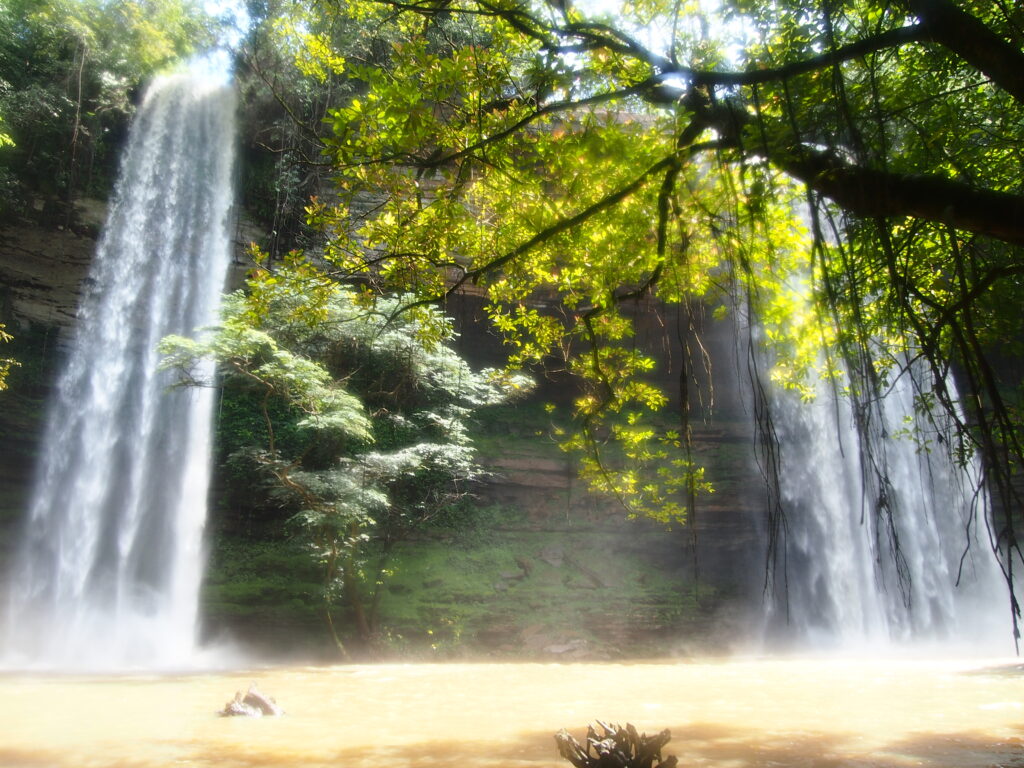
Why Visit Boti Falls?
Boti Falls is more than just a waterfall—it’s part of a larger eco-tourism experience that includes caves, giant rock formations, and hiking trails leading to panoramic viewpoints.
What Makes Boti Falls Special?
- Twin Waterfalls: The “male and female” waterfalls create a spectacular view, especially during the rainy season.
- Hidden in the Forest: The falls are surrounded by dense vegetation, making the journey to them feel like an adventure.
- Spiritual Significance: Locals believe the merging of the two falls signifies harmony and blessing.
- Multiple Attractions Nearby: The site also features Umbrella Rock, Three-Headed Palm Tree, and Mysterious Caves.
Activities at Boti Falls
There’s more to Boti Falls than just watching the water cascade. Here’s what visitors can do:
- Hiking to the Falls – A short but scenic trek of about 250 steps leads to the waterfall.
- Swimming – While the pool at the base is shallow, visitors are allowed to wade in the water.
- Explore Umbrella Rock – A 45-minute hike from Boti Falls, this giant rock formation provides a spectacular view of the surrounding forest.
- Visit the Three-Headed Palm Tree – A rare natural wonder located near the falls.
- Birdwatching & Photography – The lush environment is home to many exotic birds and butterflies.
- Picnicking & Relaxation – The area around the falls has benches and shaded spots, making it ideal for a quiet retreat.
Best Time to Visit
Boti Falls is at its most spectacular during the rainy season (April to October) when the water flow is strong, and the twin falls merge. In the dry season (November to March), the water levels drop, and the falls are less impressive.
Accommodation Near Boti Falls
For those planning to stay overnight, options include:
- Capital View Hotel (Koforidua) – A modern hotel with comfortable rooms and a pool.
- Riverside Hotel – Located near the falls, offering a natural setting with great views.
- Guesthouses in Koforidua – Budget-friendly lodges and guesthouses for travelers looking for affordable stays.
How to Get to Boti Falls
- From Accra: Take a bus to Koforidua (approx. 2-3 hours). From Koforidua, take a taxi or minibus to Boti Falls (about 30-45 minutes).
- From Koforidua: Taxis and motorbikes are readily available to take visitors to the falls.
Estimated Costs
- Transportation from Accra to Koforidua: GHS 40–80 (by bus), GHS 200+ (private car hire)
- Entry Fee: GHS 20–30 (Ghanaians), GHS 50–100 (foreigners)
- Guide Fee for Nearby Attractions: GHS 50–100 per group
- Accommodation: GHS 150–500 per night, depending on comfort level
- Food & Refreshments: GHS 30–80 per meal
Nzulezu: The Stilt Village on Lake Tadane
Nzulezu, located in the Western Region of Ghana, is a truly unique destination. This stilt village, built over Lake Tadane, is one of the most remarkable places in West Africa. The village is home to an indigenous people known as the Nzema, who have lived in harmony with the water for centuries. Surrounded by lush greenery, the village offers an experience like no other, with houses and paths built on stilts above the water.
The name “Nzulezu” translates to “Surface of Water” in the local language, a fitting description for this water-bound community. It remains largely undiscovered by mainstream tourists, making it a hidden gem worth exploring.

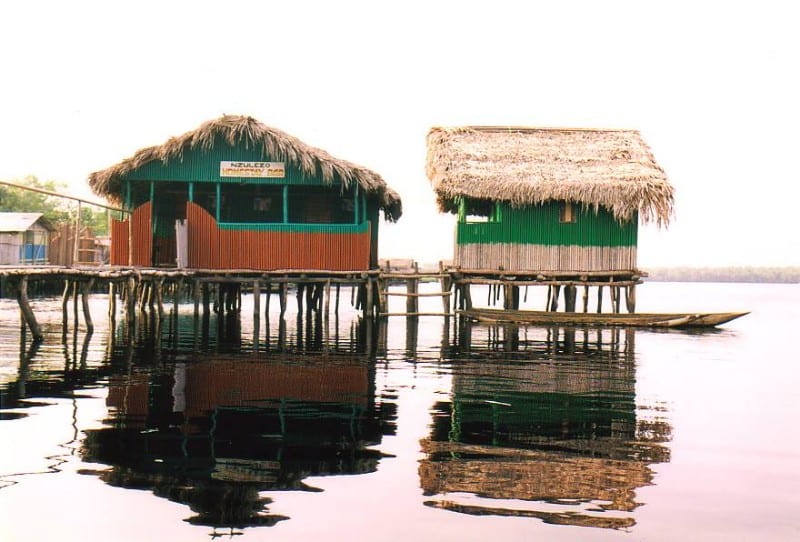
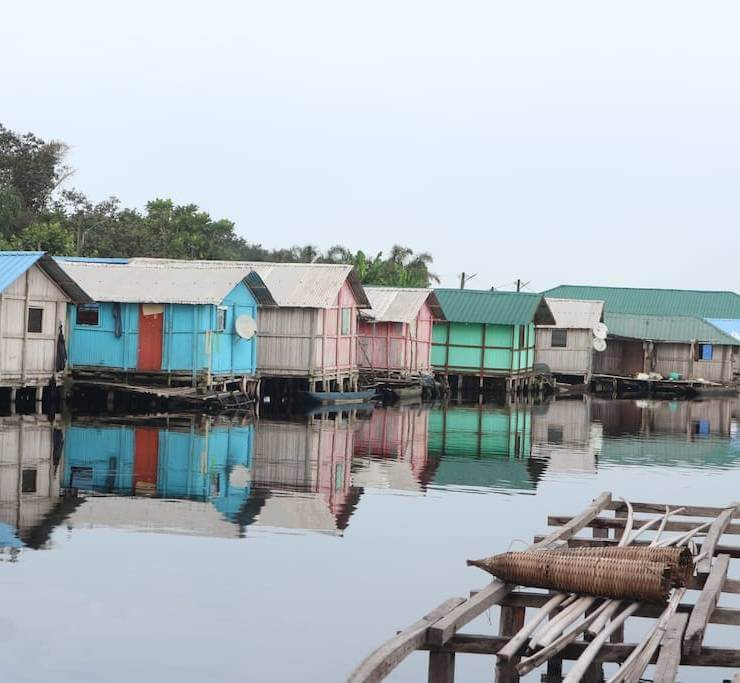
Why Visit Nzulezu?
Nzulezu is more than just an interesting village; it offers an opportunity to experience a unique cultural heritage that has survived for centuries. Visitors are not just tourists but guests in a community that is as welcoming as it is fascinating.
What Makes Nzulezu Special?
- Unique Location: A village built entirely on stilts, floating over a serene lake.
- Traditional Lifestyle: The Nzema people continue to live as they have for centuries, using canoes as their primary means of transportation.
- Cultural Significance: Nzulezu is recognized by UNESCO as a cultural heritage site.
- Unspoiled Nature: The surrounding forest and waters create a tranquil, scenic environment.
Activities in Nzulezu
A visit to Nzulezu is centered around experiencing the village life and exploring its surroundings. Here’s what you can do while you’re there:
- Boat Ride to Nzulezu – The journey to the village takes about 1-2 hours by canoe from the nearest town of Beyin. The ride itself is peaceful and offers a beautiful view of the surrounding wetlands and forest.
- Village Tour – Once you arrive, you’ll take a guided walking tour of the village. Your guide will explain the history and traditions of the Nzema people.
- Canoe Ride through the Village – You can rent a canoe to row through the village and enjoy the peaceful waters.
- Swimming & Fishing – If you’re feeling adventurous, you can swim in the calm waters of the lake or even try your hand at fishing using traditional methods.
- Photography & Bird Watching – The surrounding area is rich in wildlife, making it an excellent spot for photographers and nature enthusiasts.
Best Time to Visit
The best time to visit Nzulezu is during the dry season (November to March) when the waters are calm, and the weather is more predictable. Visiting during the rainy season may result in difficult conditions, but it can also add a mystical touch to the surroundings.
Accommodation in Nzulezu
There are no hotels directly in the village, but visitors can stay in nearby towns and villages such as Beyin. A few options include:
- Eden Lodge (Beyin) – A small, rustic lodge near the village offering basic amenities and beautiful views of the lake.
- Nzulezu Guesthouse – A budget-friendly option in Beyin that provides simple rooms and local meals.
- Canoe Bay Resort – Located by the shore, this resort offers a more luxurious stay with a variety of activities.
How to Get to Nzulezu
- From Accra: Travel to Takoradi (about 5-6 hours by bus), then take a car or taxi to Beyin (approx. 1 hour).
- From Takoradi: You can arrange transport with your accommodation or a local taxi to Beyin, where you will take a canoe ride to Nzulezu.
Estimated Costs
- Transportation from Accra to Takoradi: GHS 60–150 (by bus), GHS 250–400 (private car hire)
- Canoe Ride to Nzulezu: GHS 40–60 per person
- Entry Fee to Nzulezu: GHS 20–40 per person
- Accommodation: GHS 80–200 per night
- Food & Refreshments: GHS 30–60 per meal
The Volta Region: Waterfalls, Villages, and Scenic Beauty
The Volta Region of Ghana is often overlooked by tourists, but it is one of the country’s most picturesque and tranquil destinations. Known for its lush mountains, peaceful villages, and stunning waterfalls, this region is an adventurer’s dream. With a mix of natural beauty and authentic Ghanaian culture, the Volta Region is the perfect spot for those looking to explore beyond the typical tourist sites.
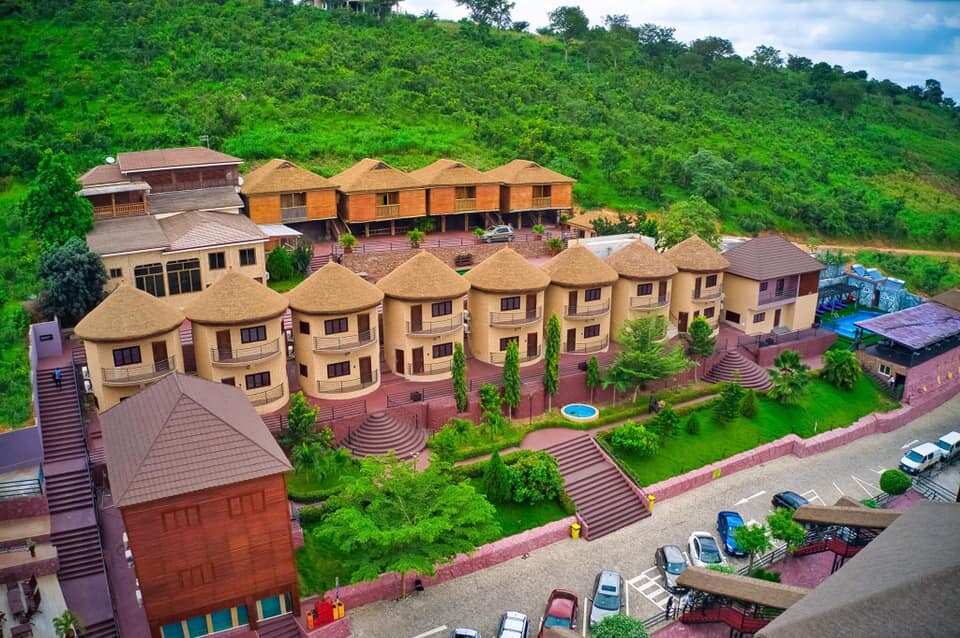
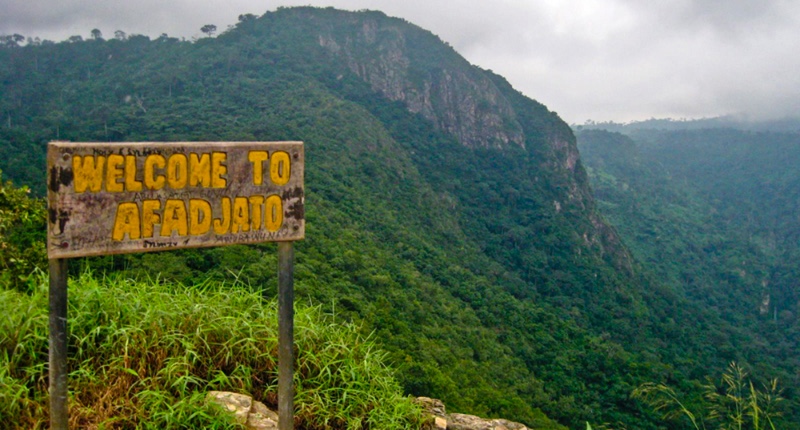
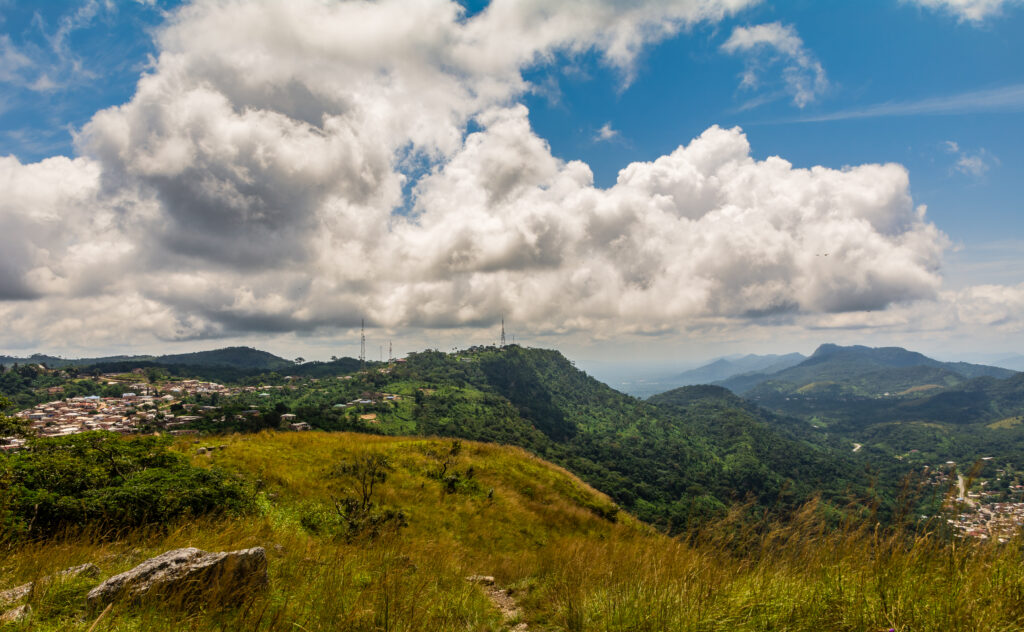
Why Visit the Volta Region?
The Volta Region offers visitors a unique combination of stunning natural landscapes and rich cultural experiences. From the majestic waterfalls to the serene villages, there’s a lot to explore in this less-visited part of Ghana. Whether you’re a nature lover, history buff, or cultural enthusiast, you’ll find something here that captures your heart.
What Makes the Volta Region Special?
- Natural Beauty: With waterfalls, hills, and lakes, the Volta Region is a haven for nature lovers.
- Authentic Experience: The region is home to small villages where you can experience Ghanaian traditions and lifestyles in their truest form.
- Peaceful Atmosphere: Unlike the bustling cities of Accra or Kumasi, the Volta Region offers a quiet retreat from the crowds, perfect for relaxation and reflection.
- Cultural Heritage: The area is rich in cultural history, with the Ewe people being the primary ethnic group.
Top Attractions in the Volta Region
The Volta Region is home to several hidden gems that offer a blend of natural beauty, adventure, and culture. Here are some must-visit spots:
- Wli Waterfalls
- Overview: Wli Waterfalls is the highest waterfall in Ghana and one of the most beautiful in West Africa. Located in the town of Wli, near the border with Togo, it’s a serene spot to visit. The waterfall cascades down from a height of over 60 meters, surrounded by lush greenery, making it an ideal location for photography, hiking, and relaxation.
- Activities: Take a guided hike through the lush forest to the base of the waterfall. The journey is as beautiful as the destination, with the sound of water rushing through the forest.
- Best Time to Visit: The waterfall is best visited during the rainy season (May–September) when the falls are in full flow.
- Mount Afadjato
- Overview: Mount Afadjato is the highest peak in Ghana, standing at 885 meters. It offers a challenging but rewarding hike with panoramic views of the surrounding area. The climb is not overly difficult, but it is a great way to experience the natural beauty of the region.
- Activities: Hike to the top and enjoy breathtaking views of the landscape, which stretches all the way to Togo. The hike takes about 2–3 hours depending on your pace.
- Best Time to Visit: Visit during the dry season (November–March) for the best weather conditions for hiking.
- Tafi Atome Monkey Sanctuary
- Overview: The Tafi Atome Monkey Sanctuary is home to a population of monkeys, particularly the mona monkeys. The sanctuary is part of an ongoing effort to protect the species and is located in the village of Tafi Atome. Visitors can engage with the friendly monkeys, who are not shy about interacting with people.
- Activities: Take a guided tour to see the monkeys in their natural habitat. The villagers also offer cultural performances and demonstrations to enrich your visit.
- Best Time to Visit: The sanctuary can be visited year-round, but it’s best to go during the dry season (November–March) for pleasant weather.
- Lake Volta
- Overview: Lake Volta is one of the largest artificial lakes in the world and a major geographical feature of the region. The lake, formed by the Akosombo Dam, offers scenic views and plenty of opportunities for boating and water-based activities.
- Activities: You can take a boat tour on Lake Volta or visit one of the nearby resorts for a relaxing time by the water.
- Best Time to Visit: The dry season (November–March) is ideal for boat trips on the lake.
- Amedzofe Village
- Overview: Amedzofe is one of the highest villages in Ghana and offers a picturesque retreat with stunning views. The village is known for its serene environment and is a great place for eco-tourism and learning about local farming practices.
- Activities: Hike to nearby viewpoints, visit local farms, or just enjoy the peaceful atmosphere of this charming village.
- Best Time to Visit: Visit during the dry season to enjoy the best weather.
Accommodation in the Volta Region
While the Volta Region is not as developed in terms of luxury accommodations, there are several comfortable and affordable lodging options:
- Volta Serene Hotel (Ho) – A comfortable hotel offering modern amenities and a relaxing atmosphere.
- Wli Waterfall Lodge (Wli) – A guesthouse offering a rustic experience, located close to the waterfall.
- Tafi Atome Guesthouse (Tafi Atome) – A budget-friendly guesthouse with basic amenities, perfect for visitors exploring the monkey sanctuary.
- Mount Afadjato Resort – Located near the foot of Mount Afadjato, this resort offers stunning views and a peaceful environment.
How to Get to the Volta Region
- From Accra: Take a 5-hour bus ride or drive to Ho, the capital of the Volta Region. From there, you can hire a taxi or take public transport to reach the various destinations.
- From Takoradi: It takes about 5-6 hours by bus to reach the Volta Region.
Estimated Costs
- Transportation from Accra to Volta Region: GHS 30–80 by bus.
- Entry Fees to Attractions: GHS 10–30 per person (depending on the site).
- Accommodation: GHS 70–150 per night for mid-range hotels and lodges.
- Food: GHS 20–50 per meal at local restaurants.
Tafi Atome Monkey Sanctuary – A Unique Wildlife Experience in the Volta Region
Nestled in the lush Volta Region of Ghana, Tafi Atome Monkey Sanctuary is a unique wildlife sanctuary dedicated to the conservation of the monkey species that reside in the area. The sanctuary is located near the small village of Tafi Atome and is home to a population of Colobus monkeys, which are considered sacred by the local community. The sanctuary is not only a haven for wildlife but also offers an enriching cultural experience, as visitors have the opportunity to engage with the local community and learn about their traditions and conservation efforts.
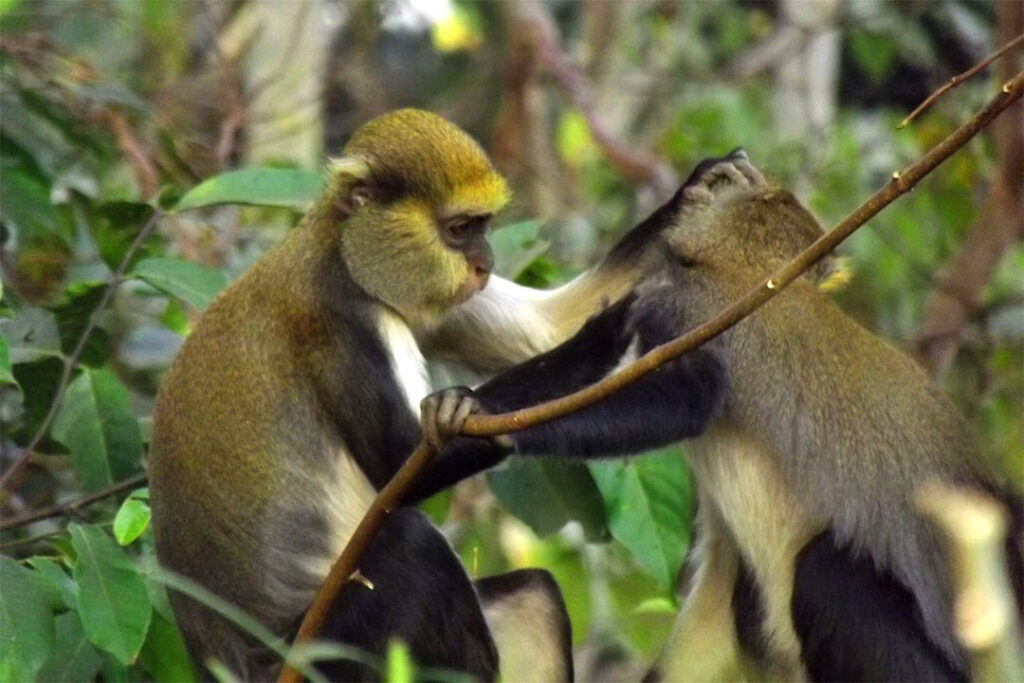

Why It’s a Hidden Gem:
Tafi Atome is not widely known to international tourists, which makes it a hidden gem in Ghana’s vast array of natural attractions. The sanctuary’s serene atmosphere and the chance to interact with the monkeys up close make it a one-of-a-kind experience. It’s an excellent destination for those looking to connect with nature, wildlife, and local culture.
What Makes It Special:
- Sacred Monkeys: The Colobus monkeys at Tafi Atome are considered sacred by the local people. Legend has it that they are the descendants of a clan that was blessed by the gods. This cultural belief adds a layer of intrigue and reverence to the sanctuary, making it a unique site for nature and culture enthusiasts alike.
- Wildlife Conservation: The sanctuary plays an important role in the conservation of the Colobus monkeys, which are often threatened by deforestation and human-wildlife conflict. The community’s involvement in preserving the monkeys ensures their survival while also providing eco-tourism opportunities for visitors.
- Interactive Experience: Visitors can take guided tours to see the monkeys in their natural habitat, and they may even have the chance to feed and interact with them. It’s a fantastic opportunity for nature lovers and families to witness wildlife up close in a sustainable and ethical way.
- Cultural Connection: Tafi Atome is also a great place to experience local culture. The villagers actively participate in preserving the sanctuary, and they offer insights into the traditions and beliefs surrounding the monkeys. Visitors can learn about the village’s commitment to sustainable tourism and wildlife protection.
Things to Do in Tafi Atome Monkey Sanctuary:
- Monkey Watching: The main attraction of the sanctuary is the chance to observe the monkeys in their natural environment. The Colobus monkeys are known for their striking black-and-white fur and acrobatic movements. Visitors can spend time watching them leap from tree to tree and play in the forest.
- Guided Tours: A local guide will take you through the sanctuary and explain the cultural and ecological importance of the monkeys. The guides are knowledgeable and passionate about the preservation of the sanctuary, offering a deeper understanding of the area’s significance.
- Cultural Immersion: Engage with the local community and learn about their traditional beliefs surrounding the monkeys. The villagers have lived in harmony with the monkeys for generations, and visitors are often welcomed to participate in rituals and ceremonies that are important to the community.
- Bird Watching: The sanctuary is also home to various bird species. Bird watchers will enjoy spotting colorful species while exploring the forested area.
- Nature Walks: Explore the scenic landscape surrounding the sanctuary, which is filled with lush vegetation and natural beauty. The area is perfect for nature walks, photography, and simply soaking in the tranquility of the environment.
How to Get There:
- Location: Tafi Atome is located in the Volta Region of Ghana, about 12 kilometers from the town of Hohoe. It is roughly a 4-5 hour drive from Accra.
- Traveling by Road: To get to the sanctuary, you can drive from Accra to Hohoe and then follow local directions to Tafi Atome. The road conditions can vary, so it’s advisable to travel with a local guide or use a tour operator that can help with transportation.
- Guided Tours: Many tour operators offer guided trips to the sanctuary, providing transportation, a guide, and additional information about the area’s cultural and ecological significance.
Best Time to Visit:
The best time to visit Tafi Atome is during the dry season, from November to April, when the weather is more predictable and suitable for outdoor activities like wildlife watching and nature walks. However, the sanctuary is open year-round, and the monkeys are active throughout the year.
Ideal For:
- Wildlife Enthusiasts: If you’re a nature lover or wildlife photographer, Tafi Atome provides an excellent opportunity to see the Colobus monkeys in their natural habitat and learn about wildlife conservation.
- Culture Seekers: The sanctuary offers a unique cultural experience, as visitors can learn about the local community’s relationship with the monkeys and their spiritual significance.
- Families: Tafi Atome is a family-friendly destination where kids can learn about wildlife conservation and enjoy an interactive experience with the monkeys.
- Eco-Tourism Advocates: For those passionate about sustainable tourism, Tafi Atome provides a model of how local communities can contribute to conservation efforts while benefiting from eco-tourism.
